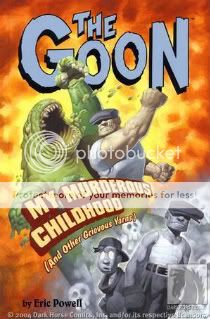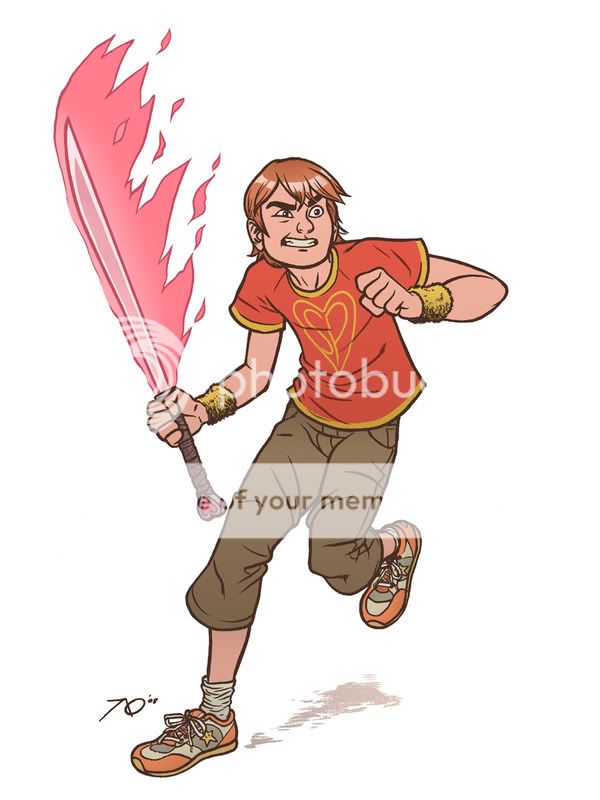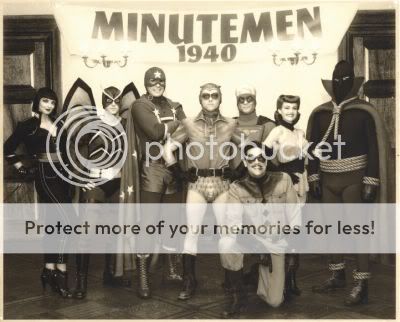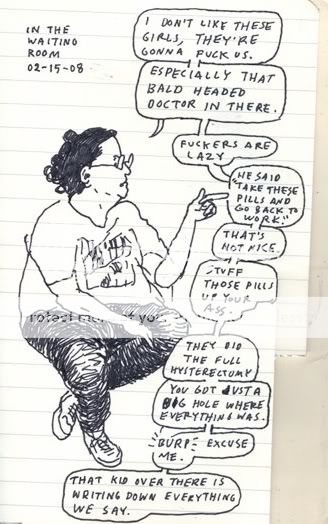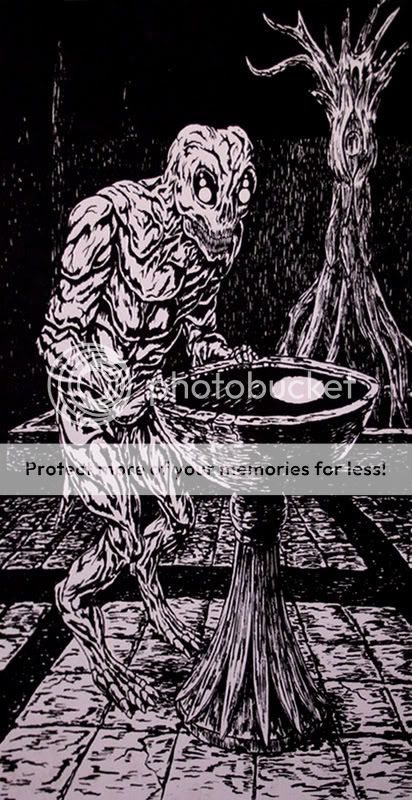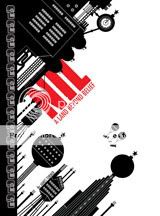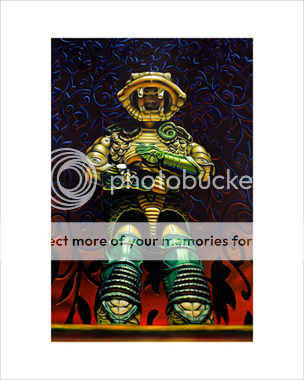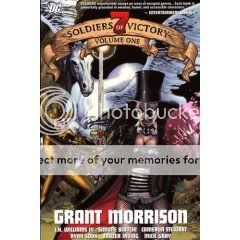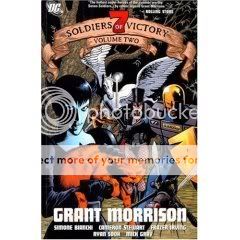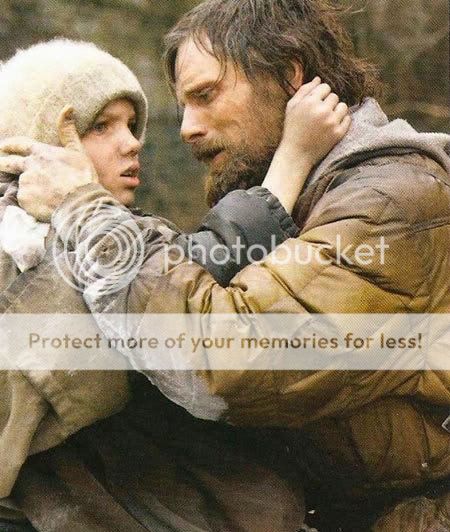Archive for May 31, 2008
Carnival of souls
May 31, 2008* It was a big week for Grant Morrison comics, with the debut of Final Crisis and new issues of All Star Superman and Batman‘s “Batman: R.I.P.” storyline. Douglas Wolk annotates Final Crisis #1, while Jog reviews All Star Superman and touches on the other two books in passing. And I found myself agreeing with nearly everything Graeme McMillain said in his review of FC #1.
* And now for a pair of interesting reviews of films I liked: Ian Garrick Mason on No Country for Old Men and Rob Humanick on Rambo.
* CRwM at And Now the Screaming Starts finishes off his series of posts on torture porn by addressing the earnest tone and political content of the films.
* There’s
* How big of a T-shirt nerd am I? Big enough to seriously consider ponying up $200+ for a subscription to a series of 13 limited-edition Venture Bros. shirts–available for sale for one week only following the premiere of each new episode from the show’s third season–despite never having seen the show. (It’s next on my Netflix queue after I finish Deadwood.) (Via Topless Robot.)
* Matthew Perpetua, ahem, succinctly reviews Joss Whedon and John Cassaday’s Giant Size Astonishing X-Men #1.
* Finally, “Dee-Moh-NAY, Dee-Moh-NAY!”
I’m Lossy
May 30, 2008Because I am an idiot, by the time I posted my latest “Why oh why don’t people like Lost the way that I like Lost” screed yesterday I somehow managed to completely forget the whole reason I started writing it, which was this:
I realized yesterday that the constant barrage of Lost-as-game theorizing and “masochistic delirium” and so on we’ve all been subjected to may be preventing me from being able to enjoy those aspects of it–that in some theoretical world where there’s less of that going on to drive me up a wall and interfere with what I find the main attraction of the show to be, I’d be much more into that sort of thing. Am I letting reverse peer pressure blind me to what may well be the genuine pleasures of treating Lost like a puzzle, theorizing madly about it, working myself up into a weekly frenzy? I honestly don’t know. I remember doing more theorizing back in the day, before doing so took on such a manic feel, so maybe there really is something to this.
Anyway, the season finale was last night. So far I’ve enjoyed Mark Coale’s mellow recap. Alan Sepinwall’s relentless naysaying during Season Three is why I stopped reading him on the show, and to the extent that it creeps up in his review of last night’s episode I’m glad did, but I at least discovered this peach of a post in his comment thread. (Via Jim Treacher.)
Comics Time: The Goon Vols. 0-2
May 30, 2008The Goon Vol. 0: Rough Stuff
Eric Powell, writer/artist
Dark Horse, April 2004
96 pages
$12.95
The Goon Vol. 1: Nothin’ But Misery
Eric Powell, writer/artist
Dark Horse, July 2003
136 pages
$15.95
The Goon Vol. 2: My Murderous Childhood (And Other Greivous Yarns)
Eric Powell, writer/artist
Dark Horse, May 2004
128 pages
$13.95
Originally written on July 26, 2004 for publication in The Comics Journal
‘Tis a strange fate that the breakout success story of Dark Horse’s recent attempt to craft a line of horror comics around its flagship title Hellboy turns out to be not so much Hellboy as Hellboy Junior. But such is The Goon, Eric Powell’s ongoing riot of hard-boiled noir tough guys, zombie splatstick, and Warren Comics pastiche. It’s unsurprising that its similarity to Mike Mignola’s endlessly fascinating tales of paranormal fisticuffs are both The Goon’s great strength and, by comparison, its great weakness.
The Goon takes place in what’s becoming a fairly common type of indie-genre-comic city, one that’s a melange of trash conventions thrown into a blender and poured onto the page. This one encompasses down-home hillbilly thugs, Edward G. Robinson-style gangsters, haunted houses of EC vintage, and so forth. (See also Street Angel‘s combination of mad scientists, b-boying ninjas, pirate conquistadors, and skateboarding female teen martial-arts experts.) The titular strongman (think Hellboy with a hat instead of horns, Sin City‘s Marv with a wifebeater instead of a trenchcoat, The Thing as a Tennessee redneck instead of a New York Jew) is the terror of the city’s underworld, serving as a brutal enforcer for the reclusive mob boss Labrazio. But a raging gang war against “the nameless man, the zombie priest” and his undead crime family has made the Goon and his Little Orphan Annie–eyed sidekick Frankie into the city’s unlikely saviors. As they’re all that stands between the city and uncontested zombie dominance, the Goon and his pal are forgiven their (ahem) enthusiasm for their work of roughing up lowlifes, werewolves, evil elves, giant fish people, et cetera, usually conducted with knives, Magnums, shotguns, huge monkeywrenches, talking chainsaws, et cetera.
Et cetera and ad nauseum, I’m afraid. Perhaps I’m simply armchair-editing the book, angling for it to become the type of genre fiction I personally enjoy, but the endless game of can-you-top-this splatter and silliness overpowers what could be a very interesting crime-horror concept. Now, I’m certainly not asking for the humor to be excised completely. There are moments that work hilariously–Frankie’s repeated “KNIFE IN YOUR EYE!” gag is in gloriously bad taste, and the reactions of the people of the Goon’s burned-out burg to his rampages are terrific in that “aieeeeeee!” sort of way. (“Look out!” says one bum in Volume One as the Goon gives the business to an arachnid poker cheat named (you guessed it) Spider. “He’s gone strangle crazy!”)
The problem is that when Powell gets serious, or seriously creepy, he’s clearly at his best. The Goon’s origin story, besides containing a pretty brilliant twist that alters our perception of his present-day behavior, packs a surprisingly emotional wallop. (I’m guessing Vito Andolini Corleone’s start in The Godfather Part II was the inspiration, and in this case the imitation is indeed flattering.) “What have I got to live for?” asks the Goon of his new friend Frankie as they embark on their first (and what seems at the time to be likely their last) gang-enforcer outing. At this point you’ve seen the Goon beat up, chewed up, and thrown up by nearly every monster known to man, and yet this clear-eyed (literally, for this panel only) expression of nihilism makes you feel the characters’ risk. Similar hints at a larger emotional tapestry are intriguing (a gorgeous dame whose romantic overtures the Goon thinks are too good to be true, the long and sordid history of the zombie priest), as is the fact that the hero of this story is himself a brutal criminal who looks good only in comparison to the cannibal zombies that fight with him for territory. Often these flashbacks are drawn in an evocative pencil-heavy style with far greater depth than the increasingly slick Saturday-morning cartoonisms that comprise the remainder of the series, to the flashbacks’ great benefit. But all this is inevitably drowned out by the next beheading, the next disemboweling, the next appearance of a spontaneously combusting orangutan. No, I didn’t make that last one up. Such is The Goon.
At a Loss
May 29, 2008Tonight is the two-hour season finale of Lost, preceded by a slightly expanded version of last week’s penultimate episode (technically the first part of the finale). Meanwhile, to hear the critics tell it, this is the best season of Lost since the first, if not ever. Why? The explanation used to be that signing a deal that cemented an endpoint for the series gave the show’s cast and creators a renewed sense of purpose, but you don’t hear that much in the thinkpieces popping up hither and thither today regarding the finale. No, the explanation they give is that this season, with its embrace of the flashforward device that made its debut during the last ep of Season Three, has made it a televised mind game par excellence.
Here’s Juliet Lapidos (whose name makes her sound like she’s a Lost character herself) at Slate:
…only in the current season, which ends Thursday night, has Lost achieved complexity and intricacy worthy of the critical attention it’s been receiving all along….the writers have shaken themselves out of the old formula–and are finally attempting a truly high-wire narrative move.
Here’s Ginia Bellafante in The New York Times:
“Lost,” which concludes its fourth season on ABC on Thursday night, refuses our passive interest while it denies us the satisfaction of ever feeling that we might confidently explain, to the person sitting next to us at dinner, that we have a true grasp of what is going on — of who among the characters is merely bad and who is verifiably satanic. To watch “Lost” is to feel like a high school grind, studying and analyzing and never making it to Yale. Good dramas confound our expectations, but “Lost,” about a factionalized group of plane crash survivors on a cartographically indeterminate island not anything like Aruba, pushes further, destabilizing the ground on which those expectations might be built. It is an opiate, and like all opiates, it produces its own masochistic delirium.
Here’s Emily Nussbaum at New York, making the clearest case yet for Lost-as-puzzle in a piece straightforwardly entitled “Why Lost Is the Best Game Show in TV History”:
[The introduction of flashforwards] flipped the Lost game board out fifteen squares in each direction. It expanded the show’s setting from the island to the world. It raised the level of narrative difficulty, both for the writers and for the fans, pivoting elegantly away from “Will these people get off the island?” and complicating the whole notion of “What will happen next?” (And I’m not even getting into the whole time-travel thing.)
But best of all, it made the show’s appeal weirdly clear: that this is as much a game as a story. It’s no surprise I find myself talking about the level of difficulty; it feels very much like we’re leveling up. My husband, who is a video-game critic, pointed out that Lost online commentary often feels less like a response to a story and more like the way fans deconstruct an ARG, an alternative reality game, participating in communal puzzle-solving and focusing obsessively on tiny details.
You say this like it’s a good thing!
Even moreso than the widespread fanboy venom spat at the show during early-mid Season Three, my disconnect from the nerd CW regarding the proper approach to the show has thrown me for a loop this year. Back then, it was easy enough to simply ignore the constant bitching and nitpicking and enjoy Lost for what, to me, it is: a byzantine sci-fi mystery about the choices we make–from romantic to philosophical–when confronted with failure.
But this year is different, because now that I’m no longer seemingly alone in enjoying the show anymore, I’m discovering that the way others are enjoying it may be limiting my ability to do so is well, or at least limiting the ways in which I’m able to do so.
First of all, I simply don’t find the show impossible to follow or explain, because it isn’t! The only thing that makes it so is if you deliberately throw yourself against the rocks of the “unknown unknowns” that make up the show’s mysteries. As I’ve pointed out at length, it’s no more possible to “figure out” “what’s going on” in the show’s mythology now than it was at the end of Season One, when we’d yet to see a Dharma Initiative logo, take a visit to Others Village, time travel with Desmond, meet anyone with the surname “Linus” or “Widmore,” see a four-toed statue, summon the smoke monster, hear the phrase “Oceanic Six,” and on and on and on. There’s tonight’s season finale and two full seasons between us and getting to the ass-end of Lost‘s full complement of everything-you-know-is-wrong revelations.
So the show is incomprehensible only to the extent that you insist upon trying to comprehend it. I choose rather to appreciate it the same way I would any other great show–the performances, the writing, the criminally overlooked cinematography–or any other great science fiction story–eye-opening ideas, fun technology, Frankensteinian terror–or any other great mystery–wondering whodunnit and guessing from time to time but not trying to construct elaborate theories of who what when where why how even though there’s still a full third of the book to go–or any great pulp story–digging the types and tropes and sex and violence.
In other words, I don’t find it to be a high-school grind–but beyond that, I don’t see why that’s pleasurable! It’s not just that people are driving themselves into “masochistic delirium,” it’s that they adamantly feel that that is the best way to experience the show! I’m not a masochist and I’m not feeling delirious. I don’t want to solve a narrative. I want it to unfold–and the genius of Lost, to me, is that it’s all about that unfolding. Why try to jump ahead of it?
UPDATED BECAUSE I’M STUPID AND FORGOT TO INCLUDE THE WHOLE POINT OF THIS POST IN THE POST WHEN I FIRST POSTED IT:
However, I realized yesterday that the constant barrage of Lost-as-game theorizing and “masochistic delirium” and so on we’ve all been subjected to may be preventing me from being able to enjoy those aspects of it–that in some theoretical world where there’s less of that going on to drive me up a wall and interfere with what I find the main attraction of the show to be, I’d be much more into that sort of thing. Am I letting reverse peer pressure blind me to what may well be the genuine pleasures of treating Lost like a puzzle, theorizing madly about it, working myself up into a weekly frenzy? I honestly don’t know. I remember doing more theorizing back in the day, before doing so took on such a manic feel, so maybe there really is something to this.
Five years, that’s all we got
May 29, 2008Today is my fifth blogoversary. (That’s even if you factor in a brief hiatus in 2004-2005, since I blogged for a few months prior to being here and for a few months elsewhere during the hiatus.) Thank you for reading!
Carnival of souls
May 28, 2008* I’ve been reading up on serial killers again in order to get in the right headspace for a project, so I’m catching more such stories in the news. Meet husband and wife serial-killer team Michel Fourniert and Monique Olivier, recently convicted of abducting, raping, and killing a series of virgin girls throughout France and Belgium.
* Matthew Zoller Seitz stops in at the Movie Geeks United podcast to discuss Sylvester Stallone’s Rambo series, touching on Indiana Jones, John McClane, Jason Bourne, Jack Bauer, Dirty Harry Callahan and other action icons. His segment starts at 42:24. (Via The House Next Door.)
* FourFour’s Rich Juzwiak assembles an awesome continuous mix of songs that sample Chuck Brown and the Soul Searchers’ seminal drum break from the song “Ashley’s Roachclip.” (It’s the beat from “Set Adrift on Memory Bliss,” “Unbelievable,” “Paid in Full,” and “Girl You Know It’s True.”) That, as they say, was a good drum break.
* Hey, look, it’s the trailer for the Chuck Palahniuk “Fight Club with fucking instead of fighting” adaptation Choke! (Via AICN.)
* And here’s a report from the set of the post-apocalyptic Cormac McCarthy adaptation The Road from the New York Times. Heh, I wonder what Dan Simmons makes of the director’s claim that this eschatological scenario is “realistic.”
* Here’s a pair of interviews with Lost‘s great Michael Emerson. Pseudospoilerishesque if you want to go into the season finale with no expectations whatsoever, but delightful for fans of how Emerson has become the de facto non-Lindelof/Cuse spokesperson for the show. (Via Whitney Matheson and Jim Treacher.)
* Jason Adams at My New Plaid Pants defends Hostel from unfavorable comparisons to Inside–which he also liked, but for different reasons than…well, here, read this quote:
just because you put on airs of importance by throwing a bone to some random social or political message,…it doesn’t instantly make your film more worthwhile.
* Check out artist Joe Quniones’s de-O’Malleyified takes on the cast of Scott Pilgrim! (Via David Paggi.)
* Speaking of O’Malley, he brings us your quote of the day:
I did not win a contest and I was never an overnight success. The instant-gratification-American-Idol mindset is so sad, so damaging. Everyone I know who’s successful got that way by hard work, gradual building of an audience, nonstop hustling, plenty of luck.
Comics Time: The ACME Novelty Library #18
May 28, 2008The ACME Novelty Library #18
Chris Ware, writer/artist
ACME Novelty Library/Drawn & Quarterly, December 2007
56 pages, hardcover
$17.95
Cruelly overlooked by many year-end best-of lists (my own included) due to its late-in-the-game arrival (now a perennial occurrence) and, perhaps, a level of quality we’ve come to take for granted, the latest installment of The ACME Novelty Library is a tough book to review by virtue of the fact that it belongs at or near the top of any such list worth a damn. In trying to express what is so compelling to me about Ware’s work in general or this book in particularly I am, to quote Stephen King on Clive Barker, almost literally tongue-tied. Instead I’m rambling on about year-end best-of lists, and eventually I’ll be enthusing vapidly. (Hey, it could be worse–I could be complaining about the people who find his work cold, emotionless, and boring. Specifically I could be calling those people morons. How lucky for you, then!)
In this particular case I’m kind of floored by how Ware assembles a panoply of snippets of a lonely young woman’s life–some are lengthy flashbacks, others are day-in-the-life moments, still others are seen from the perspective of the old building she lives in–into this sort of long seamless tapestry of ache. Like the tiny diagrammatic panels Ware foisted on an unsuspecting comics world, these narrative building blocks give the material an engaging ebb and flow, and simultaneously ape the way the protagonist’s own life flows without pause one dreary day into the next, occasionally enlivened by reverie or some small humiliation. Now that I think of it, she herself looks back on her life’s more exciting or rewarding times as dreams–temporary and illusory. And in a real way this book could go on forever, or at least as long as our heroine remains stuck in this (seemingly lifelong) rut, this cycle going on and on the same way some of Ware’s pages (the knockout front endpapers, for example) are all but cyclical. This chapter itself doesn’t really end, it just stops, which is perfect.
I don’t know, what should I say? He’s the best colorist, the best letterer? Those things are both true. His line is superhuman, like a machine made it, which is why people think it’s cold, but they’re wrong because he’s using that precision to nail specific and devastating emotions and sense-memories–my god, that moment where the heartbroken heroine sinks into her dormroom bed! “I lay there, facing the fake wood wall shelf…but it might as well have been the blackness of space…” The image has the pull of a black hole. And as it turns out Ware is also quite good at cartooning sex, particularly that delirious brand of first-flush collegiate sex, daily coupling and mutual masturbation and the raw, almost manic hunger to have and give and demonstrate pleasure. Cold schmold! All with the best chops in terms of line and layout of anyone in comics. The funny thing is I don’t really think of comics when I read this, I think of my life and my wife’s life and my friends’ lives and complete strangers’ lives, which of course is what makes it the very best kind of comics there is.
Tortured logic
May 27, 2008After a bang-up start inspired by the League of Tana Tea Drinkers’ roundtable on the subject, CRwM of And Now the Screaming Starts’ has posted two more entries in his “A Defense of Torture Porn” series, and frankly I’m so knocked out by them I don’t know where to begin other than by saying “go read them from start to finish.”
First, he(? just assuming here) advances a five-part definition of the subgenre, calling attention not just to “there’s torture in them” a la my own attempt at playing Webster, but also characterizing their emotional tone, visual style, sociopolitical approach, construction of suspense through paranoia and helplessness, and absence of supernatural actors.
Next, he counters the frequently leveled assertion that torture porn is inherently inartful, crass, and exploitative by rebutting the idea that it’s a subgenre of dreary realism as opposed to the horrifying heights reached by supernatural (or “High”) horror. It’s really so marvelously constructed that you should read it yourself, but just let me call out this passage:
First, let me defend my claim that torture porn is fantasy by focusing on the visual style that has become torture porn’s most distinctive trait. The look of torture porn is not realistic, but hyper-realistic. It is a highly artificial approach that takes the trappings of realism and blows them all out of proportion. The result is a lavish, over-stuffed look – most often taking an archetypal image and stuffing it to the breaking point. This is most apparent in the dungeon settings of the two Hostel flicks and the bathroom set of the first Saw. Both sets are not just dirty, but absolutely coated in grime and slime. One imagines you could get tetanus of the eyeball just from looking at them. But neither represents what (sadly) we know torture looks like. Real torture, when governments undertake it, is conducted not in sewers, but in relatively orderly places that look disconcertingly like hospitals. Why leave a filthy crime scene behind? Mud and crud tends to trap potential clues like hair, foot and fingerprints, and so on. The answer, of course, is that these aren’t “real.” They visually represent the feelings the idea of torture evokes. Men in rubber aprons, faces hid behind monstrous brass and steel facemasks, power tools inexplicably left to rust (despite the fact that they are supposedly the property of an elite club of super rich people) – it all suggests the moral, spiritual, ethical decay of what’s happening. The whole visual approach adopted by Roth and Wan is not realistic some much as it represents the typical strategies of film realism – a little grime here, some busted glass there – and invests it with symbolic purpose. The very fabric of their films’ worlds reflects the mental state and fate of their characters.
Man oh man. Read also for his (accurate) attribution of the look of torture porn to David Fincher’s Se7en, his analysis of the significance of that miscellaneous torture device on the cover of the DVD for Hostel, and much, much more.
What do I make of all this? Well, it’s a much more effective “defense” of torture porn than my own. But to be fair to me, I wasn’t defending the genre, just the term. What CRwM is doing is making the case that the genre’s defining characteristics have the potential for great horror art. My only concern is that in so doing, he perhaps allowed himself to fiddle with his designation and delineation of those defining characteristics so as to reach that conclusion.
Maybe it’s possible that the only torture porn movies are the Hostel and Saw franchises, as he argues. But in a way, what he’s doing is the same kind of definitional sleight-of-hand that so irks me when mainstream critics do the “If It’s a Horror Movie and It’s Good, It Must Be Transcending the Genre” rag–in other words, they define the genre so as to preclude the possibility of good art, so that when good art comes along it’s not part of the genre, it’s something else. You’ve seen this done with “torture porn”-as-pejorative, by the way; CRwM is, in a way, offering the flipside of that. Now, he isn’t saying that torture porn movies are good, just that they can be good–but he’s doing so by reducing the definition to being applicable only to a very, very narrow set of films, which to me is kind of a cheat. If “torture porn” can’t also be used to describe Audition, Turistas, The Passion of the Christ and so on, what good is it? Don’t we on some level instinctively understand that the goals of those films, in terms of the torture content, is largely the same? Would we settle on (or for) a definition of “slasher” that only included Halloween and Sleepaway Camp? Whatever you might say about my definition of torture porn, I think it’s a lot more useful–it’s basically just a film in which the primary fear engine is the immobilization and brutalization of somebody. To me at least, the conceptual richness of those two “-ization”s gives you all the freedom you need to make a more elaborate case for the genre’s inherent interest.
This sort of brings me around (finally!) to Curt Purcell’s provocative response to my monumental horror-image theory/essay. What sticks in Curt’s craw about it is how far I swing the pendulum in the opposite direction of violence and gore in terms of trying to get at the images that “define” horror. Might not seeing ostentatious violence as a sort of Freudian doubling of the monumental horror-image–the actualization of such an image’s potentiality, the yang unconsciously called to mind by the yin–enable us to construct a Grand Unified Theory of Horror?
The answer: yes, it might. But I fear that the drive to do so stems from me overstating my case in my original essay. That essay’s genesis was pretty simple: Over the years I discovered that certain types of images–the Shining twins, the Wicker Man–scared me more than anything else in horror movies. But when I turned to the literature to see what had been said about it, the answer was, basically, nothing. Most horror scholarship focused on gender- and sexuality-based explorations of horror violence and horror monsters, rather than these kinds of images. So I went about cobbling together an explanation for how and why such images did what they did. Again, they were, to me, the scariest images to be found in horror; meanwhile, contra the “transcending the genre” crowd, I believed that a genre should be defined by its best works–in this case, its scariest. Hence, calling the monumental horror-image the “definitive” horror-image, heavily implying if not stating outright that this is as opposed to the violence and gore.
BUT! It’s that “as opposed to” that gets me in trouble. Never did I intend my praise of the monumental horror-image to mean that other kinds of horror images should be excluded, that they didn’t count, that they couldn’t also be super super scary or creative or effective or disturbing or Art with a capital A. The gore and violence that Curt attempts to loop into an expanded conception of what makes horror imagery tick is perfectly valid and requires no such expanded conception, at least as far as I’m concerned, because I was trying to define a very precise set of images, not the genre overall. Those images work best for me for (I think) the reasons described in the essay, but they’re not the only images that work, for me or for anybody else, and I have no ambitions to state otherwise. Similarly, there may be torture porn films that work best, or even just embody certain principles the best, but ironically the less ambitious definition covers more ground and is therefore more useful, I think.
Carnival of souls
May 27, 2008* Steven Wintle has posted the farewell edition of The Horror Roundtable. I stole my entry from My Life With the Thrill Kill Kult’s Buzz McCoy’s contribution to the liner notes of the WaxTrax! box set, but my favorite valedictory has to be T Van, who drops the greatest, and most underutilized, Seinfeld quote of all time.
* Apparently Battlestar Galactica‘s ratings are up, but what really struck me about the Hollywood Reporter article stating as much was this passage about the show’s current direction:
The numbers are also surprising since “Battlestar” has as many fans frustrated with the current season as enthralled. The storylines have turned the show’s longtime shades-of-gray character morality into a muddy and often indecipherable quagmire of interlocking mythology, with a slew of formerly down-to-earth human and cylon characters elevated to quasi-deities pondering their higher purpose.
I don’t think it’s all that indecipherable–I don’t find Lost hard to follow either–but other than that, yeah, that’s kind of a downer, isn’t it? Not surprisingly, the focus on mythology seems to have completely energized various BSG fans of my acquaintance who made the transition over to the show via Netflix’d DVDs after hearing “Hey, you like Lost? You’ll like BSG too!” The current Battlestar storyline seems tailor-made to fan the guessing-game flames that mark Lost‘s most ardent fans. (Via Whitney Matheson.)
* I’m fond of saying I didn’t read comics as a kid, and this is basically true. However, around the time that I saw Batman and read The Dark Knight Returns, I was massively into Marvel trading cards. In one of the all-time great acts of cluefulness, my buddy Ryan Penagos at Marvel.com has posted every single Marvel Universe Series I trading card. I found this via Gary Wintle, who writes that he took the cards so seriously, he thought the “joke” cards were canonical. I’d imagine there are a lot of us out there whose ideas of heroic fantasy were shaped in a fairly fundamental way by these cards.
* Quentin Tarantino’s gonna shoot and complete his long-mooted World War II epic Inglorious Bastards in time to premiere it at Cannes next year? I’ll see it when I believe it. (Via AICN.)
* Behold, Watchmen‘s Minutemen! Folks, this is why they didn’t give the modern-day superheroes spandex costumes. (Via AICN again.)
* Speaking of Watchmen, you know the pirate story Tales of the Black Freighter from the comic? A direct-to-DVD animated adaptation by Zack Snyder and company will come out days before the Watchmen theatrical release. Clever. (Via SciFi Wire.)
* Also at SciFi Wire, Incredible Hulk director Louis Leterrier says his movie is both a reboot of and sequel to Ang Lee’s Hulk film (I guess he does, it’s not a direct quote), sources the movie’s inspiration to the ’70s TV series and the Jeph Loeb/Tim Sale graphic novel Hulk: Gray, and promises you won’t have to go 40 minutes into the movie to see the Hulk for the first time.
* Comic Book Resources has a preview of the latest Mike Mignola/John Arcudi-scripted B.P.R.D. miniseries, War on Frogs. The B.P.R.D. banner is basically the best ongoing superhero comic on the stands for the past three years or so–better than Hellboy proper, if you ask me. Bonus points for old-school artist Herb Trimpe’s Guy Davis impersonation.
* My experience with actor-director Sydney Pollack is basically limited to his role as Ziegler in Eyes Wide Shut and his black-comic bluebeard cameo in The Sopranos. That being said, I loved Matt Zoller Seitz’s two-paragraph comment-thread obit, not just as a reminder of how great a film writer Seitz is, but for the way it effortlessly implies an ocean of interesting work beneath the surface of every “So-and-So Dead at 73” headline.
* Go, look: New Anders Nilsen comics.
* Go, read (and disagree vehemently at least twice): Tom Spurgeon on this summer’s blockbuster movies.
* The Vault of Horror’s B-Sol reviews Inside, the French horror film I’m clearly the last person in the horror blogosphere to see.
* The humor of recognition: Ten Arcs That Most Superheroes Must Endure Even Though Almost None of Them Should. (Via Matthew Perpetua.)
* Finally, the owls are not what they seem.
Carnival of souls
May 26, 2008* The next best thing to being there: Tom Spurgeon has posted his utterly epic annual guide to attending the San Diego Comic-Con. Updated and hilarious, it will really, really make you wish you could go.
 * A different kind of guide: Cryptomundo’s Loren Coleman has complete coverage of a controversial recent Bigfoot-expert conference at which analyst M.K. Davis more or less asserted that the specimen seen in the famous Patterson-Gimlin footage is a) human b) wearing a braid c) the victim of a gunshot to the leg that was inflicted by one of the filmmakers. Yes, seriously.
* A different kind of guide: Cryptomundo’s Loren Coleman has complete coverage of a controversial recent Bigfoot-expert conference at which analyst M.K. Davis more or less asserted that the specimen seen in the famous Patterson-Gimlin footage is a) human b) wearing a braid c) the victim of a gunshot to the leg that was inflicted by one of the filmmakers. Yes, seriously.
* B-Sol at Vault of Horror takes a look at the modern zombie movie’s famine years, the 1990s.
* At her blog, actress/eccentrix Bai Ling reviews Andrew Lloyd Weber’s The Phantom of the Opera. Yes, seriously.
* Curt Purcell takes a whack at the wack notion that the only really scary fiction is about stuff that can actually happen, preparing to argue why supernatural horror is the sine qua non of the genre. The post is also a slight walk-back from his position regarding the overvaluing of fear among horror fans–worth a read if you’ve been following Curt’s thoughts on that matter.
* By the way, I owe Curt a response to his post on my “monumental horror-image” theory.
* Go, look: Mat Brinkman art at the Stairwell Gallery (via Monster Brains.)
Comics Time: Nil: A Land Beyond Belief
May 26, 2008Nil: A Land Beyond Belief
James Turner, writer/artist
SLG, April 2005
236 pages
$12.95
When I was in middle school and first got into Monty Python, I assumed that most grown-ups knew all about philosophers, because Python had so many jokes about them. As it turns out the kinds of grown-ups who know all about philosophers first learn about them as kids in middle school who get into Monty Python, so it’s a bit of a self-perpetuating system. Anyway, Nil sort of takes this premise for granted–it’s like the looooooooooooooongest Monty Python philosopher sketch ever, with liberal doses of Brazil thrown in for good measure. Unfortunately it’s not funny, let alone as funny as Python or Gilliam solo. The basic idea is that there exists a dystopian land called Nil that embodies nihilism in its many conflicting forms, where people pilot big wrecking ships that destroy literal outgrowths of belief, and which is at war with a similar antithetical nation called Optima. The people of Nil spend almost all their time one-upping each other as to who best embodies the principles of nihilism, such as they are–except for our hero, Proun Nul, who yearns for something more. Or maybe he just yearns to have sex with the lovely Miss Void, I don’t know. The problem is that the concept never quite seems sure what it wants to be. Is Nilean nihilism a matter of literal, physical warfare against belief as a living thing, or is it the usual matter of debate and argument? If Nil is resolutely anti-capitalist, why is every page covered in ad parodies? If Nil is resolutely anti-totalitarian, why is it such an ersatz Oceania? Is it a model of efficiency, or of incompetence? Maybe some kind of point is being made here of the nonsensical nature of nihilism to begin with, but it feels more like an attempt to cram in every kind of joke available than a coherent choice of satire. It’s kind of baffling and it leaves the jokes without any solid ground to pivot off of, and it’s not as though any of the characters are developed in any sense but the most broad and parodic since they have no constants to play against. By the end of its 236 pages, which seemed a lot longer, I really didn’t care anymore. All told, the five or six minutes of total screen time given to the Nihilists in The Big Lebowski are a more effective satire of that anti-belief system and the excesses of the life of the mind in general.
All of this is compounded by Turner’s art, which is designy and iconic in the extreme. I’m sure there’s a perfect point of comparison out there that I’m totally missing, but what it calls to mind for me is flash animation, or some very old computer program, or Legos…it’s resolutely cold, flat, and artificial. This can occasionally lead to startling images–generally speaking, the bigger the weapon of war, apartment complex, or Nihilist temple, the cooler Turner makes it look through accrued geometric patterns. (Remember those flying bomb ships in Super Mario Bros. 3, with all the propellers and cannons and things? Kinda like that.) But for the most part it’s deliberately unlovely, making empathy or even awe impossible. It kind of substitutes cleverness for the usual kinds of qualities that make art compelling–of which cleverness is one, of course, but not the only one.
In some ways I think it’s exciting that a book like this can get made and published, but it wasn’t for me.
Carnival of souls
May 25, 2008* Guillermo Del Toro and Peter Jackson did an online Q&A about the two upcoming Hobbit movies, and the transcript is here. (Via AICN.) Kristin Thompson runs down some of the highlights–John Howe, Alan Lee, Howard Shore, Andy Serkis, and Ian McKellen are all confirmed for both films, for example–but for my money the most interesting thing (not necessarily good, just interesting) is Del Toro’s comments regarding supplementing the Weta design and effects teams with his own staff.
* B-Sol at Vault of Horror says that The Strangers‘ tendentious “inspired by a true story” claims indicate a studio with something to hide, but isn’t that just the exact same hyperbole used to promote The Texas Chain Saw Massacre back in the day. For me it has more to do with the film’s deliberately old-school promotional campaign rather than trying to pull the wool over people’s eyes (though based on a conversation with my non-horror-fan little sister about the movie, that’s happening too).
* AICN has links to some fun clips from The Incredible Hulk. Looks like a good time to me.
Comics Time: Thor: Ages of Thunder
May 23, 2008Thor: Ages of Thunder
Matt Fraction, writer
Patrick Zircher, Khari Evans, artists
Marvel, April 2008
36 pages
$3.99
A while ago I linked to a video of crudely animated Thors performing Slayer’s “Raining Blood” and, in a post that got some attention here and there around the Internet, said basically that Thor comics should be at least that metal. If your Thor comic doesn’t evoke Led Zeppelin’s “Immigrant Song,” there is something wrong with your Thor comic. Needless to say, there’s been a lot wrong with a lot of Thor comics by that standard.
In Thor: Ages of Thunder, writer Matt Fraction takes a big step in the right direction. The action primarily consists of Thor attacking and beheading enormous frost giants, then dragging their heads into Asgard as trophies; between these feats he has sex. With the exception of the two included stories’ introductory pages, everything is done in big two-page spreads. There are shots of Thor’s war hammer Mjolnir dripping with gore. The chorus of the one Zeppelin song that explicitly references Thor, “No Quarter,” is paraphrased. The coming attraction page for the book’s sequel reveals its title to be Thor: Reign of Blood.
But in much the same way that it doesn’t quite get the “No Quarter” chorus right and didn’t quite name its follow-up after the Slayer album, it doesn’t quite gel overall. Mostly this is because of the narration captions in virtually every panel. It’s not that they’re knowingly overwrought–that’s as it should be–it’s just that there are way too many of them and there are way too many words in each. A action comic about gods warring with giants and constructed solely of two-page spreads should flow effortlessly, but the constant jibber-jabber stops both the eye and the brain short when they should be on cruise control. Show us how awesome your Thor is, don’t tell us. Moreover, I just happened to have read a whole lot of mythology-based comics recently, whether we’re talking about short stories in Mome or minicomics by Eleanor Davis and Matt Wiegle or flashbacks in Incredible Hercules, and the captions make this one feel comparatively belabored.
There’s also a disparity between the art in the two stories. Patrick Zircher’s detail-driven art packs genuine power, and the witty coloring by June Chung (dig the red noses she gives everyone–after all, it’s chilly in the realm of the Norse gods!) puts it over the top; Khari Evans’s figures, particularly his women, seem awkwardly proportioned and inconsistently constructed by comparison. (Though his Thor itself is quite strong, and he’s one of the first artists I’ve come across who truly conveys that Thor flies because he throws his hammer so hard the thing pulls him up off the ground with it.)
That being said, it’s all enormously more appropriate to a character based on gods worshipped by the priests who gave us the term “berserkers” than a leisurely rumination on the cyclical nature of existence set within the rural farms and diners of Oklahoma. It’s also entirely possible, perhaps even likely, that a collection of stories of this type (which is surely in the offing given the announced second issue) will make for a satisfyingly loud read, and be priced more efficiently to boot. In much the same way that I’m comforted that most kids’ first exposure to the potentially awesome character of Iron Man will be from Jon Favreau’s movie rather than Mark Millar and J. Michael Straczynski’s comics, I take great solace in the hope that somewhere, some kid is reading this while listening to the copy of Black Sabbath Volume 4 he stole from his older brother rather than reading something that will lead him to form the opinion that “Thor is boring.”
Carnvial of souls
May 22, 2008* Well now, here’s a treat: A very, very entertaining interview with Michael Emerson, aka Ben from Lost, by the Daytona Beach News-Journal‘s Tom Iacuzio. It’s full of both spoilers and speculation, so be careful, but the adorable thing is that the speculation comes from Emerson himself rather than the interviewer! Emerson also has some interesting things to say about Deadwood and Battlestar Galactica. And then there’s this wonderful little exchange:
What kind of reaction do you get from fans on the street?
Mostly people react to me with pleasure but in general it’s a kind of guarded pleasure. They are happy to see this face and voice that they know belongs to a character that they enjoy but part of them can’t fully disassociate me from the part I play. So they worry a little bit that I might actually be somewhat dangerous.
Do you ever just shoot them that patented Ben stare?
(pause) I don’t even know what you’re talking about.
Read the whole thing. (Via The Tail Section.)
* Buncha Marvel movie news that has me kind of excited. First, there’s a film adaptation of Runaways on the way, with a screenplay by series writer and Lost ass-kicker Brian K. Vaughan himself. (Via JK Parkin.) Second, displaying an admirable level of cluefulness, Marvel Studios President Kevin Feige sez the upcoming movie versions of Captain America and Thor will take place during World War II (entirely) and in Asgard (partially) respectively. Sweet.
* Artist Robert Burden is selling prints of his awesomely over-the-top portraits of action figures! (Via Uncrate.)
* You’ll never not be entertained while reading Rick Marshall talk about Wizard.
* CRwM of And Now the Screaming Starts has some really interesting things to say about torture porn, specifically regarding how the audience is implicated by the events taking place, and whether we who debate the term agree at all on what we’re referring to when we use it. Since a chunk of it is based on an interpretation of my definition of torture porn, I respond and defend myself here.
* Finally, Kali Ma!
Breaking news
May 22, 2008My friend Kiel Phegley was let go by my former employer Wizard yesterday. This stinks, not just because Kiel is a terrific person and a very, very good writer who you’d think they’d bend over backwards to hang onto, but also because it reduces to just David Paggi a cadre of indie-friendly staffers that as recently as last September included Dave, Kiel, myself, Rick Marshall, Brian Warmoth, and Rickey Purdin.
Anyway, Kiel would be a great hire, were I some sort of comics-related entity looking to find one.
Carnival of souls
May 21, 2008* Much anticipated by me Clive Barker adaptation The Midnight Meat Train is now headed for a July 11 release, up against Guillermo Del Toro’s sequel to his own egregious Hellboy. Bloody Disgusting’s report hints that the film may have a super-limited release.
* In a post about an unrelated project by Del Toro, Variety reports that Ian McKellen, Andy Serkis, and Viggo Mortensen have all been approached to reprise their Lord of the Rings roles in the Hobbit movies. This appears to indicate that Aragorn’s stealth adventures in Rohan, Gondor and the like will play a role in that not-as-mysterious-as-everyone’s-making-it-out-to-be second film. Kristin Thompson caught it and offers further thoughts.
* Say it ain’t so! Strange Ink’s Sean is officially hanging up his blogging spurs. Bad news for fans of strange pop-culture ephemera and/or naked ladies. (Why choose?)
* There’s an awful lot to disagree with in Ted Pigeon’s essay on Frank Darabont’s adaptation of Stephen King’s The Mist.”Sociopolitical policies” are not the “most important” aspect of adapting this story, nor is it the case that “no single image in The Mist is more frightening than the sharp blade grasped on one end by human hands plunging into the stomach of a fellow man.” Indeed I think the film’s hamfisted focus on the former and misplaced belief in the latter is part of what hurt it in the end. Face it, people like The Mist (or at least this person does) because it features giant, ugly, disturbingly unique monsters plucking people out of a grocery store and eating them, not because of anything the character of Mrs. Carmody tells us about religious fundamentalism; and to the extent that the opposite might be true, the movie version has a spotty record at best with treating such elements with the deftness they require. That being said I’m happy to have found Pigeon’s essay (courtesy of The House Next Door’s Keith Uhlich), because it’s clear he’s actually taking the film seriously on its own terms rather than as a tee of which to smack the wiffle ball of “reflectionist” pontificating. I look forward to browsing through the reviews listed in his sidebar.
* Scrubs: The New Class? No thank you. (Via Whitney Matheson.)
* Sylvester Stallone says there may be a director’s cut DVD release of Rambo down the pike, which would restore the film’s original title, John Rambo. That’s the newsworthy(ish) part of AICN’s story, but perhaps more exciting is their reposting of a YouTube clip comprising the climax of Rambo in its entirety–the most insanely violent five minutes of film you will ever see. I’m serious, this thing is completely…wow, words are literally failing me. Now I DO NOT RECOMMEND WATCHING THIS IF YOU HAVEN’T SEEN THE WHOLE MOVIE FIRST. It’s a very unusually structured movie that kind of explodes into this climactic sequence, and seeing it by itself before you’ve seen the rest of the movie will really dilute one of the most unique action-movie-watching experiences you’re likely to have. So be warned. But if you have seen the movie, this is heaven.
Comics Time: JLA Classified: Ultramarine Corps and Seven Soldiers of Victory Vols. 1-4
May 21, 2008JLA Classified: Ultramarine Corps and Seven Soldiers of Victory Vols. 1-4
Grant Morrison, writer
Ed McGuinness, J.H. Williams III, Cameron Stewart, Frazer Irving, Ryan Sook, Pasqual Ferry, Billy Dallas Patton, Freddie E. Williams II, Yanick Paquette, Doug Mahnke, artists
DC Comics, 2002-2007
JLA: 144 pages
Vols. 1 & 4: 224 pages
Vol. 2 & 3: 176 pages
$14.99
Buy Seven Soldiers from Amazon.com
Inspired by the delightful reading experience of working through the bulk of Grant Morrison’s recent, weird Batman run in one go, I decided to revisit his most ambitious project to date: The interlocking miniseries Klarion the Witch-Boy, Frankenstein, Zatanna, Mister Miracle, The Manhattan Guardian, The Bulleteer, Shining Knight, and Seven Soldiers—known collectively as Seven Soldiers of Victory. I started with the epic’s unofficial prequel, the three-issue JLA Classified miniseries Ultramarine Corps. In a way that earlier title is emblematic of all of Morrison’s output for DC. While nominally it revolves around a StormWatch/Authority-style take-no-prisoners super-team he introduced during his late-’90s JLA tenure and now updated for the Ultimates era, its villain is a revamped golden-age baddie (Nebula Man/Neb-U-Loh) who is now set up to be the ultimate weapon of eventual Seven Soldiers villains the Sheeda; themini also directly references characters and concepts (the Sheeda queen) that Morrison wouldn’t be using for another couple of years, and others that would pop up not just in Seven Soldiers but also in seemingly disconnected books like Batman (the Club of Heroes) and even the non-continuity All Star Superman (the Infant Universe of Qwewq). In other words–and this is fitting given Morrison’s view of spacetime as a single, physical living organism–what looks like a three-issue slushpile Justice League story is in fact simultaneously drawing from Morrison’s past, present, and future at the company. It’s all one big mega-story.
In this day and age of decodable genre entertainments, it’s tempting to spend this review of a re-read making connections and unearthing clues. I certainly did some of this during the re-read itself (one of my pet projects was pinpointing all four elemental golems mentioned by Baby Brain Stargard in the first Guardian issue.) It was also inevitable that I spent much of the re-read just blocking the plot out in my head in a more accurate way than I did the first time around. For example, I now think I have a pretty firm grasp on the exact roles played by the four main villains–Gloriana Tenebrae, Melmoth, Zachary Zor, and “Dark Side,” whereas if you’d asked me a couple days ago I’d have gotten the middle two conflated and had no idea how the first was connected to the fourth. Finally, given how directly the plot of the Mister Miracle mini–Darkseid’s forces win the eternal war of the New Gods and descend to Earth in the form of outwardly normal humans–mirrors what we’re told to expect from Morrison’s Final Crisis, it’s hard to resist trying to puzzle out where that mini fits in with the rest, or where the whole thing fits in with the flow of the DC Universe in general.
But I think the thing that I most want to convey about this re-read is just how affecting it is to read a superhero comic this dense. Everything I just talked about–the scattered Easter eggs, the continuity tweaks, the riot of opposing forces–are really just the tip of the iceberg in terms of the disparate elements the project comprises.In what almost seems like a self-satirical move, Morrison deliberately tapped an army of artists to illustrate the project (including one, J.H. Williams, who at various points draws in the style of every single other one) rather than allow this to happen through the vagaries of scheduling like it seems to do on all his projects. The effect is dizzying and sensuous, in no small part because this is the strongest set of collaborators he’s ever assembled, even given a hiccup in the production of Mister Miracle. Williams’ mimickry is a tour de force performance, Bianchi is a true otherworldly discovery, Sook and inker Mick Gray’s spotted blacks are sexy as heck, and Irving is a comic genius with color and facial expressions, just to name a few high points. Meanwhile Morrison himself discusses in his intro how he deliberately bounced between genres in the book, to encompass science fiction, fantasy, horror, action, comedy, soap opera, satire and more. So too does he vary up the raison d’etre of his “heroes”–none of them are in it as an exploration of What It Means To Be A Hero, which is an immediately disorienting difference from the norm as it recalibrates our expectations of what the characters will do at any given juncture. All in all it’s a bit like a supercompressed Twin Peaks or Lost–there’s just so much going on and the fun is in not knowing and trying to grok it anyway as you take succor in the crackerjack genre aspects.
The most pleasurable aspect of the project, ultimately, is that it is the challenge that the characters within face. It’s a huge story that’s just slightly too big for us to grasp from our frame of reference, but it gives off the sense that the picture is there to see if you know where and how to look at it–perhaps from the kind of vantage point that enables you to seed story points from a vast span of years into everything you write–rather than the nagging suspicion that the author has deliberately made vital information inaccessible. Trying to absorb and understand what’s going on is like standing on your tippy-toes to grab something on a top shelf, a delicious challenge to exceed your station just a bit and hold on to something outside your usual grasp, and if you don’t succeed this time, no big deal, there are any number of other angles you can come at it from. In that way the final page, one of my favorite endings to any comic ever, is a fittingly euphoric image: one of reaching.
Carnival of souls
May 20, 2008* While I enjoyed shopping at his enormous, perennial San Diego Comic Con booth as much as anyone, I never met nor knew much about late comics retailer Rory Root. Tom Spurgeon’s thoughtful obituary (accompanied by testimonials and remembrances from several industry figures) gave me a much clearer picture of what made Root a likable, interesting, and important figure.
* Here’s your first look at Viggo Mortensen in the upcoming Oscar-bait film adaptation of Cormac McCarthy’s post-apocalyptic novel The Road (via Shock Till You Drop:
* Here’s another red-band trailer for The Happening. Visual spoiler warning duly noted. (Again via STYD.)
* It’s a big day for remakes of ’80s sci-fi/fantasy cult classics with kick-ass Queen theme songs, as the Hollywood Reporter, uh, reports that remakes are afoot for both Flash Gordon and Highlander–the latter from the writers of Iron Man.
* B-Sol at The Vault of Horror draws our attention to a casting call for The King’s Stilettos, a making-of docudrama about The Rocky Horror Picture Show. Neat! Here’s their website.
* Now here’s an odd one: Guest posting at Carnacki’s The Mystery of the Haunted Vampire, Arbogast of Arbogast on Film offers an interpretation of Wes Craven’s ultraviolent Virgin Spring riff The Last House on the Left as a modern-day blood libel, pointing out how various elements of the film can be seen as (probably unintentional) echoes of anti-Semitic propaganda. Really fascinating stuff.
* And speaking of both Carnacki and Arbogast, as well as many more of your favorite horror bloggers, I’ve been inducted into the League of Tana Tea Drinkers, an elite cadre of horror-blogging types. I’ve celebrated by perusing their recent roundtable of mini-essays on torture porn, which contains viewpoints both pro and con–and both insightful and retrograde (on both sides!). For example, I was sort of shocked by T Van’s dismissal of the use of torture on Battlestar Galactica as “ridiculous” simply because some of the characters are involved are “fucking robots”–this, of course, pretty much invalidates any fantastical genre as a legitimate mode of discussing important ideas. On the other hand, while I still disagree with Curt Purcell’s assertion that fear is overvalued as a criterion for horror, I find his theory fascinating and well constructed. And then there’s a lot of longing for the good old days of more wholesome fare like the Friday the 13th movies, which seems a bit like grown-ups complaining about those crazy kids and their rock and roll to me. A few writers make the connection between torture-porn horror and torture in non-horror films–including whoever wrote the introduction, which insightfully mentioned the likes of Irreversible, The Passion of the Christ, and BSG–but few of them have seen enough of the current torture-porn wave to feel confident enough to tease that connection into a thesis of any kind.
As I’ve discussed before, I think torture porn is a perfectly fine phrase that horror fans are using almost exclusively pejoratively, in ways they didn’t do with other seemingly dismissive terms like “grindhouse,” “exploitation,” or “slasher.” So that’s problem one: these discussions lump the “good” torture porn movies (Hostel, Wolf Creek) in with the bad (Hostel Part II, the Saw sequels). Problem two is this weirdly reactionary response to torture in horror, dismissing its appreciative viewers as mindless gorehounds in ways that these critics would not tolerate for other more “traditionally” gory horror movies, while simultaneously ignoring the fact that torture porn is at least as connected to Deliverance and the climax of Nineteen Eighty-Four as it is to Halloween, at least if it’s done right.
Anyway, enough rambling from me.
Carnival of souls
May 19, 2008* I saw Iron Man and Speed Racer and then I reviewed them both!
* My friend David Paggi, one of the people at Wizard who does know who the other two guys are but alas was not in a position to stop one of the ones who doesn’t, interviews Fantagraphics’ Eric Reynolds about the company’s transition to Diamond as their direct market distributor.
* Kristin Thompson reads some tea leaves to determine that the Hobbit movies will be written by Lord of the Rings masterminds Peter Jackson and Fran Walsh (though she doesn’t mention their cowriter, Philipa Boyens).
* A trio of The House Next Door’s critics–Keith Uhlich, The Odienator, and Matthew Zoller Seitz (hopefully reports of his retirement from criticism have been greatly exaggerated!)–take on the original Indiana Jones trilogy. For my money Uhlich overwrites his piece on Last Crusade into incoherence, but Seitz is predictably compelling on the “Anything Goes” nature of Temple of Doom while Odienator nails the everything-in-its-right-place narrative economy of Raiders of the Lost Ark.
* The great young cartoonist Kevin Huizenga announces sales for several of his comics and some of his original art.
* My friend Jesse Thompson runs down the 10 Worst Album Covers by Comic Artists at Topless Robot. I think the Meat Loaf one’s worth every penny of that 45 large, actually.
* Comics wonk and commentator for hire Douglas Wolk compares the Barack Obama of those crazy email forwards your vaguely racist relatives send you to the evil mirror-image denizens of Earth-3. (Via Andrew Sullivan.)
* Tom Spurgeon reviews Grant Morrison, Geoff Johns et al’s DC Universe #0, a comic which I liked but which to no one’s surprise Tom hated. I do see what he’s getting at, though. Also, I appear to have forgotten the meaning of the word “insouciance.”
* Also on the Spurge beat, I’ve been very grumpy lately so I liked this paragraph from Tom’s post on the dire financial straits of ailing artist Gene Colan and what that portends for the industry given its history:
Comics operates under the shadow of an original sin of exploitation where caretakers and money men cash in from obliquely “managing” a property during a single quarter for greater reward than the original creator and their family might see in a lifetime. It’s an industry where elements of this kind of practice continue in the present day through, say, brutally unfair secondary rights clauses in standard contracts and no one want to talk about it because it’s unpleasant and violates some seemingly agreed-upon right that every creator must be allowed to sign a bad contract if they want or don’t know better or can talk themselves into it being for the greater good. It’s a business where some of its most devout patrons can recast what should be simple matters of creators rights and economic justice into issues of dishonor and greed based on the concern of whether or not their corporate branded fantasy fix will continue without interruption. All of this is supported by a culture of indulgence, and denial, and status based on establishing a life for oneself behind the “staff only” door without ever asking the question of whether or not that’s a life worth leading.
* But so as not to leave you on a down note, this comment from Whitney Matheson’s weekly “Best of the Lost comment thread” post put a smile on my nerdy face:
Remember in the Nikki & Paolo episode when in her flashback she was an actress in a television show and was told that they were going to reveal a major villain at the end of her show’s fourth season? It’s the end of Lost‘s fourth season.
Obligatory Iron Man and Speed Racer review post
May 19, 2008As my passive-aggressively brief review of Iron Man the other day may have indicated, I’ve about had my fill of talking about superhero movies, because I increasingly find discussion of these films (if not the films themselves) to be nothing more than acts of self-validation by nerds seeking to wash away the sins of their insular, socially disreputable hobby in the cleansing waters of Big Money and Beautiful People. Particularly insofar as these movies tend to be seen as “better” the more “seriously” they treat their subjects I have less than no use for the prevailing inter-nerd critical discourse on them and resent feeling obligated to write about them simply because they are nerd-oriented product and I am a nerd.
That said, it’s nice to see people recognizing that what makes Iron Man a good movie was that it’s fun rather than some hamfisted attempt at constructing modern myths. To me it’s fun in a fairly conventional way. It’s well-acted–Terrence Howard’s drunken explanation of why he’s proud to be an airman is one of the best character moments I’ve seen at the movies all year, and I saw There Will Be Blood at the movies this year; meanwhile, like everyone else says, I’d go see a Robert Downey Jr./Tony Stark movie even without the superhero armor. The action set pieces are exciting and the wish fulfillment is pretty kick-ass because it acknowledges problems before overcoming them–from “the icing problem” to that unbelievable sequence where Iron Man’s armor automatically targets only the terrorists in a human-shield situation). The dialogue is funny–it’s kind of like a whole movie constructed of director Jon Favreau’s Foggy Nelson scenes from Daredevil.
I suppose most importantly, every single thing they do with the Iron Man concept should make the writers of his comics for the past few years hang their heads in shame. “He’s just been a guy in a suit of armor for decades, we have to bring him into the 21st century by giving him a technoorganic virus and making him see through satellites and talk about the transformative power of cellphone technology.” Fuck you! “He’s a futurist and a surveillance-state metaphor and he’s going to beat up the World War II hero and dick over Spider-Man because of The War On Terror or something.” Fuck you too! Folks, there is absolutely nothing wrong with the idea of a rich playboy genius who builds a suit of armor in which to fuck bad guys up. If you think that there is, there’s something wrong with you, and this movie proves it. God bless it for that.
Anyway as I said it’s a fun movie and I’m certainly glad I saw it; it’s in my top tier of superhero movies. But also as I said it’s fun in a fairly conventional way. There’s really nothing in it that subverts the constraints of mainstream movie making–certainly nothing like Jack Nicholson’s weirder-the-more-I-think-about-it gay-pimp-dadaist-vaudeville Joker and Anton Furst’s art direction in Tim Burton’s first Batman movie, or even the outsized romance-violence-angst of the much maligned Daredevil and Spider-Man 3. (The closest it comes is the hilarious mechanized voices of Jeff Bridges and RDJ during the climactic fight scene.) To me there’s something a little depressing about superhero art that strips away the total fucking bizarreness of your average superhero comic, your DC Universe #0’s and what-have-you–that bizarreness is the only thing keeping art as incredibly corporate as American mainstream superheroes from slipping into the analysis-defying mercenary dreariness of “The New Mainstream” and that sort of entertainment-product. Iron Man is too sharp and too buoyant for that, fortunately.
Speed Racer, meanwhile…I really don’t get the critical reaction to it. For starters it didn’t feel too long to me. I actually got antsier during Iron Man. The race/drama/race/drama/race/drama structure felt pretty easygoing to me. Nor did I feel bludgeoned to death by its relentless brightness and fastness. I didn’t feel bludgeoned at all! Again, that up-and-down structure kept it from being relentless in the first place. And I certainly don’t get the comparison of the crowd scenes to Nazi propaganda. It’s not even a “hmm, I can see that” award ceremony at the end of Star Wars type situation–that shit is simply not there. The idea that it’s one of the worst movies ever? Completely baffling.
I thought it was beautiful to look at, and frequently funny–especially when Spritle and Chim-Chim were around (yes, that’s right!). I thought Emile Hirsch was a real disappointment, with that doughy expressionless face and mumbly voice and beady eyes that marks the leading man in this the Tobey Maguire Age, but everybody else was pretty fabulous. Matthew Fox’s clipped inflection was a scream, John Goodman (completing the takeover of this summer’s popcorn movies by Big Lebowski alums started by Bridges in Iron Man) was like every lovable uncle you’ve ever had. Man oh man, Christina Ricci, arch your eyebrow my way! And I’d totally buy Susan Sarandon’s pancake recipe, youknowwhatI’msayin’??? I even liked Bad Guy Inexplicably Not Played By Tim Curry, despite the fact that he was inexplicably not played by Tim Curry. I did wish that the visuals allowed for more weight to be given to the cars so that we could truly feel their velocity–I think the decision to show so much lateral movement and fishtailing during each race interrupted what could have been a really unstoppable display of forward momentum–but the colors and “moves” of the cars (which reminded me of the “styles” of a kung-fu-movie fighter or Immortal Iron Fist Immortal Weapon) made up for it. Overall it seemed like a fan-freaking-tastic movie for kids, like the podrace sequence from The Phantom Menace freed from the shackles of pseudo-realism and allowed to run wild, with the occasional ninja and weird British gangster thrown in.
But again I found myself weighing my enjoyment of the film against my antipathy toward the critical establishment’s discussion of it. What an astounding display of aesthetic conservatism we’ve seen from mainstream reviewers of this film, once again equating technical proficiency with soullessness as they now have done with everything from 300 to Children of Men to No Country for Old Men, and equating video-game influences with arrested adolescence (as if adolescence were a bad thing!), and equating any kind of celebration of skill and proficiency within the film with fascism, and treating the Wachowski Brothers (admittedly not the most sympathetic characters) like angry gods paying back some hero’s hubris. All because this movie is ostentatiously weird, the anti-Iron Man. We need new critics, basically. To start, here’s Jog and Jon Hastings and Ken Lowery and Ken Lowery again. Go!



